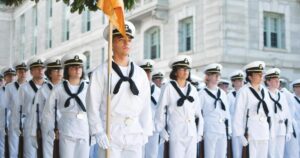On October 10, 1845, a pivotal moment in American military education occurred with the founding of the United States Naval Academy in Annapolis, Maryland. Spearheaded by George Bancroft, a historian, educator, and Secretary of the Navy, the establishment of the Academy aimed to reform and enhance the training of naval officers in response to the needs of a growing nation.
The Context of Naval Education
Prior to the establishment of the Naval Academy, the methods for training midshipmen were largely unsatisfactory. Officers were often trained through informal apprenticeships aboard ships or in a haphazard manner, leading to inconsistencies in their education and preparation for naval service. As the United States began to expand its influence on the global stage, the need for a more structured and comprehensive approach to naval education became apparent.
Recognizing the necessity for professional training in naval warfare and engineering, George Bancroft envisioned a dedicated institution that would provide midshipmen with a rigorous education, combining both academic studies and practical training.
The Role of George Bancroft
George Bancroft played a crucial role in the establishment of the U.S. Naval Academy. As Secretary of the Navy under President James K. Polk, he used his position to advocate for the formation of a formal training institution for naval officers. Bancroft believed that a well-trained officer corps was essential for the United States to maintain and enhance its naval capabilities.
Bancroft’s vision encompassed not only technical training in seamanship and navigation but also instruction in mathematics, engineering, and the sciences. He sought to create a curriculum that would produce well-rounded officers capable of leading and innovating in an evolving naval environment.
The Establishment of the Academy
The U.S. Naval Academy was officially established at Fort Severn in Annapolis, Maryland. The location was chosen for its strategic position along the Chesapeake Bay and its historical significance in American naval history. The Academy began with a small group of midshipmen and a dedicated faculty committed to the mission of providing high-quality naval education.
The initial curriculum included subjects such as mathematics, navigation, gunnery, and steam engineering. The emphasis on academic rigor and practical training set the foundation for what would become a premier institution for naval officer education.
Growth and Development
In its early years, the U.S. Naval Academy faced challenges, including limited resources and the need for qualified instructors. However, Bancroft’s vision began to take shape as the Academy expanded its facilities and curriculum. By the late 19th century, the Naval Academy had established itself as a leading institution for naval training, producing a generation of skilled officers who would serve in both peacetime and wartime.
The Academy’s focus on leadership development, technical proficiency, and ethical decision-making became hallmarks of its educational philosophy. Over time, the Naval Academy adapted to changing naval technologies and strategies, ensuring that its graduates were prepared for the demands of modern warfare.
Legacy of the Naval Academy
The U.S. Naval Academy has since become one of the most prestigious military academies in the world, with a rich history and a commitment to excellence in naval education. Its alumni include numerous distinguished military leaders, politicians, and influential figures in various fields. Graduates have served in significant roles during major conflicts, including World War I, World War II, and the Cold War.
The Academy’s influence extends beyond military service; its graduates often take on leadership positions in various sectors, including government, business, and academia. The values instilled at the Academy—honor, courage, and commitment—continue to guide its alumni throughout their careers.
Conclusion
The founding of the U.S. Naval Academy on October 10, 1845, marked a significant turning point in the training and education of naval officers in the United States. Under the visionary leadership of George Bancroft, the Academy established a legacy of excellence that endures to this day. As a premier institution dedicated to the education and development of future leaders, the Naval Academy plays a vital role in shaping the future of the U.S. Navy and ensuring the readiness of its officers to meet the challenges of an ever-changing world.












What do you think?
It is nice to know your opinion. Leave a comment.